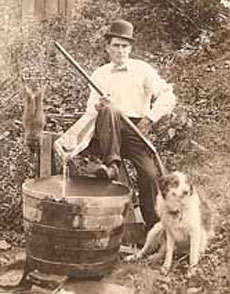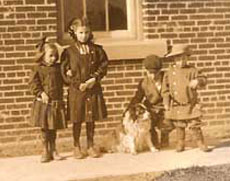The English Shepherd is a wonderful dog but they are not for everyone. They are an intelligent, high energy breed that needs daily mental and physical exercise. Please learn more about these wonderful dogs before you bring one in to your home.
The English Shepherd is descended from the same stock as the collies and shepherds of the UK. When settlers came to the US they brought their farm dogs with them and this type of dog was commonly called an "English Shepherd". It was (and is) also sometimes called the farm collie or the farm shepherd and as the English Shepherd has been recognized as a distinct breed, registered with the UKC,
since the 1930's. Photographic evidence of this type of dog is
very common. The turn of the century photos
below could have been taken with any modern English Shepherd at an "Olde Tyme Photo Booth."
The English Shepherd is a practical, "loose-eyed", working dog, with instincts to heel and drive livestock. They will adapt to the work at hand and will herd cattle, sheep, hogs, or poultry. Some have been trained for hunting. Stories of courage and problem solving are common. The English Shepherd is energetic and athletic, yet very gentle. They are noted for their calm good
judgment and are content to curl up at the owner's feet at the end of a busy day. Read Abby's Tale for an example of the English Shepherd working attitude. Abby may be exceptionally dedicated but she's very typical of the English Shepherd breed.
While very happy on a farm with chores to do, the English Shepherd makes an excellent family companion. Because of its working background and devotion to family the English Shepherd makes a great companion for an active family committed to involving their dog in their daily life. They want
to be part of the family and remain a working dog. The English Shepherd is happiest when he has a job to do; watching the kids, escorting the family to the park, and guarding the property from the wily UPS driver are all tasks the suburban English Shepherd excels at. An English Shepherd without a job will create one for himself, so families without the time to train or involve their dog in daily routines should steer away from this breed.
Check out Shep for a glimpse of a typical busy English Shepherd. Or read about Mingo, a Search and Rescue English Shepherd in Idaho.
Brief Description
Height: 18 to 24 inches at the withers.
Weight: 35 to 90 pounds. Males are usually larger than females and dogs over 60 pounds are less common and
definitely not preferred. The breed developed locally so different sizes, types or lines are common. The breed is generally considered a medium sized dog.
The English Shepherd head and neck are carried slightly raised. Ears are usually a low semi-prick, close to the head, and raised when alert. The skull is wide with only a very slight dome. The muzzle is moderately broad with a scissor bite. The nose is black and eyes are brown; their chest is deep and wide. The gaze will express intelligence and alertness. The English Shepherd coat is glossy, straight or wavy, and about 2 inches long. The topline is straight, the bushy tail is carried in a downward sweep, with the tip of bone reaching the hock. The hocks are straight, turning neither in or out. The tail is elevated when alert. An occasional natural bob-tail English Shepherd may occur in some lines.

|





